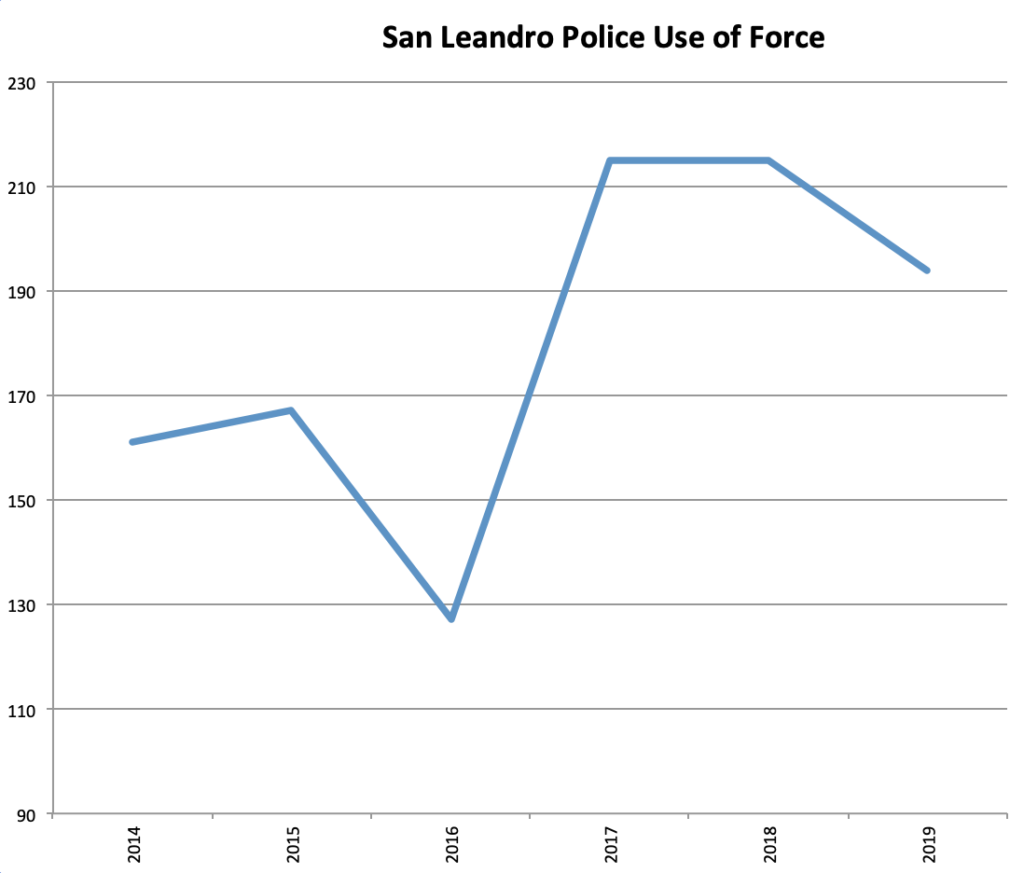When the San Leandro Police Department tried to convince the San Leandro City Council to approve its $441,306.84 purchase of body-worn cameras in May 2014, it argued that the cameras would lead to a reduction in the use of force by its police officers. However, that didn’t happen. Six years of use of force data provided by the San Leandro Police Department in response to public records requests shows that use of force increased in the years following the purchase.
During a presentation to the San Leandro City Council in May 2014, San Leandro Police Lieutenant Mike Sobek stated, “They have found through these studies that officers tend to use more verbal judo, as we call it, and suspects, knowing that there’s a camera on the officer and they’re being videotaped, and audio-taped, that they will not engage an officer as quickly as they would if there wasn’t a camera on that officer.”
Use of force by San Leandro Police increased in 2015 by six incidents from the previous year, in which body worn cameras were purchased and deployed. After a decline of 40 incidents in 2016, use of force dramatically increased in 2017 by 88. Since 2017, use of force by San Leandro Police remained the same in 2018 and declined by 21 incidents in 2019. From the first year in which body worn cameras were deployed for the entire year until 2019, use of force by San Leandro Police has increased by 27 incidents or 16%, as shown in the graphic below.

The data shows that body worn cameras did not produce the reduction in use of force that the San Leandro City Council expected when it approved the purchase on May 5, 2014. The study to which the San Leandro Police referred in which body worn cameras reduced the use of force was conducted of the Rialto Police Department in 2012. However, a significant problem with that study was that it was conducted by Rialto Police Chief Tony Farrar (listed on the study as William A. Farrar). As noted by Associate Professor Ben Brucato, “Farrar was doubly committed to his hypothesis proving true, both as a researcher and as a publicly accountable police administrator. But in the Rialto case, this is especially punctuated. The city of Rialto was ready to disband the police department and turn law enforcement functions over to the county sheriff.”
San Leandro’s experience with body worn cameras appears to more closely resemble a randomized controlled trial of body worn cameras at the Metropolitan Police Department that concluded, “We are unable to detect any statistically significant effects….Law enforcement agencies (particularly in contexts similar to Washington, DC) that are considering adopting BWCs should not expect dramatic reductions in use of force or complaints, or other large-scale shifts in police behavior, solely from the deployment of this technology.”
However, no data about use of force was presented to the San Leandro City Council when it renewed a sole source contract for body worn cameras at its June 3, 2019, meeting and none of the councilmembers asked for any data.
If body worn cameras aren’t clearly responsible for the differences in use of force, perhaps there is another explanation. Use of force by San Leandro Police increased while Sandra Spagnoli was San Leandro Police Chief from 2011 until she left in 2016. Use of force has remained the same or declined since Jeff Tudor was appointed San Leandro Police Chief.
